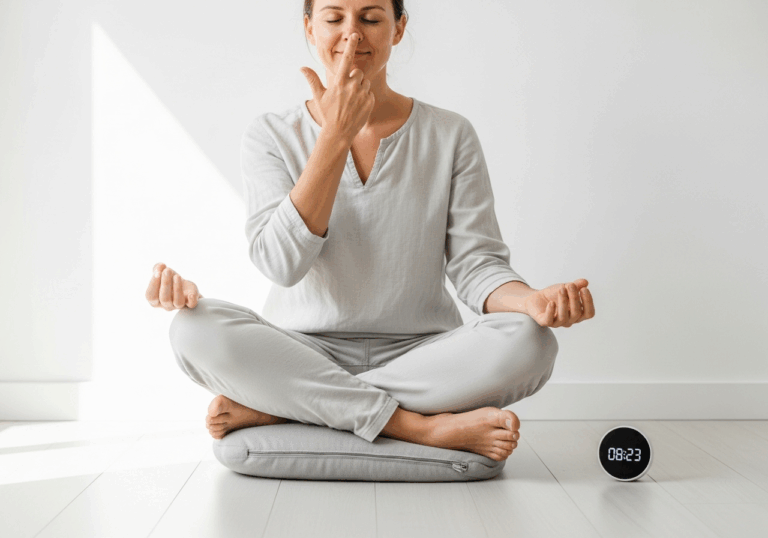Science-Backed Tips
Optimize Your Mood with Resonant Breathing
Breathing at 5.5 bpm can significantly enhance heart rate variability.
📊 Did you know?
💡 Why It Matters
1️⃣
Improving heart rate variability by 15% can enhance emotional regulation.
2️⃣
Better autonomic balance may lead to reduced anxiety and stress levels.
3️⃣
Increased LF HRV is associated with improved overall mental health.
✅ Try These Micro-Tips
🎯
Practice resonant breathing at 5.5 bpm for 10 minutes daily.
🎯
Incorporate equal inhale-exhale ratios during your breathing exercises.
🎯
Use guided breathing apps to maintain the optimal rate.
🎯
Track your heart rate variability to monitor improvements.
📚 The study
The study involved 47 participants who were assigned to practice four different breathing rates and inhale-exhale ratios.
Remarkably, the findings revealed that breathing at a rate of 5.5 breaths per minute (with a 5:5 inhale-exhale ratio) led to significantly higher levels of low-frequency heart rate variability (LF HRV) and an improved LF/HF ratio compared to the other rates tested, including 6 bpm.
This is particularly significant because enhancing HRV by just 15% can greatly improve emotional regulation, leading to better mood and reduced anxiety and stress levels.
The study underscores the importance of achieving a balanced autonomic nervous system, which is linked to overall mental health.
By incorporating resonant breathing techniques into daily routines, individuals can harness the power of their breath to foster emotional well-being and resilience.
This research not only highlights the physiological benefits of controlled breathing but also offers a practical tool for anyone looking to enhance their mental health and emotional stability through simple yet effective breathing practices.
❓ Frequently Asked Questions ❓
Learn more
What is resonant breathing?
Resonant breathing is a breathing technique that focuses on specific rates and ratios to optimize heart rate variability (HRV). It typically involves breathing at a rate that promotes balance in the autonomic nervous system, such as 5.5 breaths per minute with equal inhale and exhale durations.
How does resonant breathing affect heart rate variability?
Resonant breathing, particularly at 5.5 bpm, has been shown to significantly increase low-frequency heart rate variability (LF HRV) and the LF/HF ratio. This enhancement in HRV is associated with improved mood and emotional regulation.
What breathing rate is most effective for improving mood?
Breathing at a rate of 5.5 breaths per minute with an equal inhale-exhale ratio is found to be the most effective for enhancing mood. This specific rate promotes better autonomic balance and increases LF HRV.
How long should I practice resonant breathing?
It is recommended to practice resonant breathing for at least 10 minutes daily to experience its benefits. Regular practice can lead to improved heart rate variability and emotional regulation.
What are the benefits of increased heart rate variability?
Increased heart rate variability (HRV) is linked to better emotional regulation, reduced anxiety, and lower stress levels. It is also associated with improved overall mental health.
Can I use apps to help with resonant breathing?
Yes, guided breathing apps can be very helpful in maintaining the optimal breathing rate of 5.5 bpm. These apps often provide visual or auditory cues to assist with timing and technique.
What is the significance of the LF/HF ratio?
The LF/HF ratio is an important measure of autonomic balance, indicating the relative influence of the sympathetic and parasympathetic nervous systems. A higher LF/HF ratio suggests better emotional regulation and reduced stress.
How can I track my heart rate variability?
You can track your heart rate variability using wearable devices or smartphone apps that monitor your heart rate. Regular tracking can help you observe improvements in your HRV over time.
What is the ideal inhale-exhale ratio for resonant breathing?
The ideal inhale-exhale ratio for resonant breathing is 1:1, meaning the duration of inhalation should equal the duration of exhalation. This balance is crucial for maximizing the benefits of the breathing technique.
Is resonant breathing suitable for everyone?
While resonant breathing is generally safe and beneficial for most people, those with specific health conditions should consult a healthcare professional before starting. It is important to ensure that any breathing exercises are appropriate for your individual health status.





